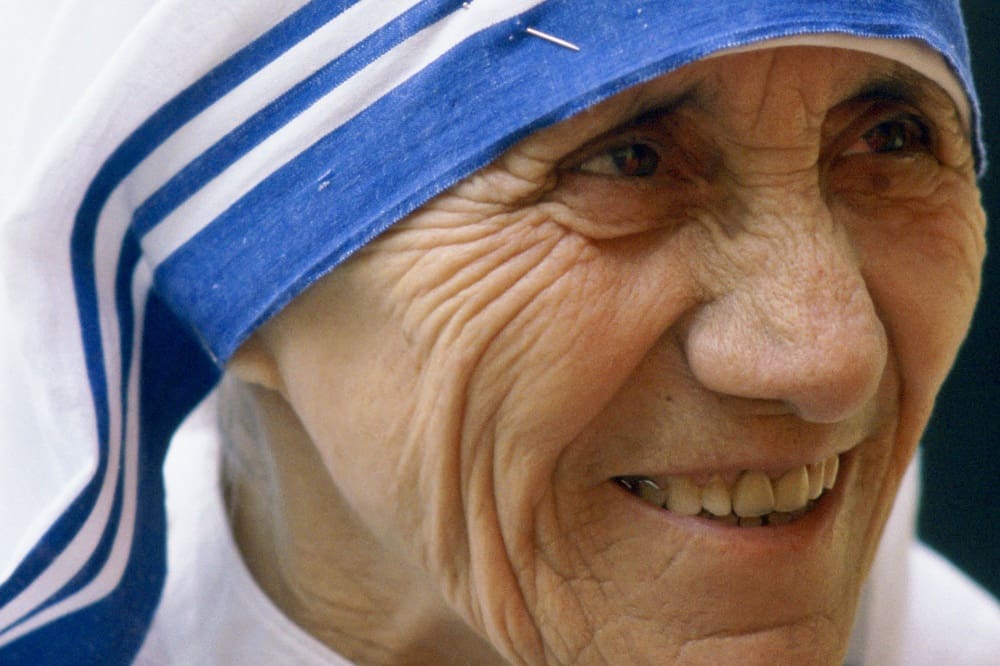The Early Visions of St. Mother Theresa
After Mother Teresa died, officials preparing her sainthood cause discovered a small cache of letters written to her spiritual directors and superiors during her early years. She had long ago destroyed her notes and diaries from this period and had asked others to dispose of letters she had sent to them. “I want the work to remain only his,” she told them. “When the beginning will be known, people will think more of me, less of Jesus.”
As if following some divine script, a few ignored her wishes. As a result, it is now possible for us to partially reconstruct the high spiritual drama of Mother Teresa’s conversion to the poor.
A Voice on a Train
In early 1947, four months after hearing the voice on the train, she wrote to Ferdinand Perier, a Jesuit who was archbishop of Calcutta. In this letter, she made her case for why he should allow her to undertake a new initiative among the poor, describing at length the voice she heard on the train and in the days and weeks that followed.
“I want Indian Missionary Sisters of Charity, who would be my fire of love amongst the very poor — the sick, the dying, the little street children,” Jesus told her. “The poor I want you to bring to me and the sisters that would offer their lives as victims of my love would bring these souls to me. You are, I know, the most incapable person, weak and sinful, but just because you are that, I want to use you for my glory! Wilt thou refuse?”
She went on to describe how she disputed with the voice she heard, which came to her often while she was on her knees after receiving Holy Communion. She told him to go find somebody else, that she was frightened of the hardship and the ridicule she would have to endure. She promised to be a good nun if only he would let her stay put in her comfortable convent. But he kept cajoling her, challenging her with the refrain: “Wilt thou refuse to do this for me?”
Jesus told her that it hurt him deeply to see so many of the poor, especially poor children, lost to sin and Satan. “Draw them away from the hands of the evil one . . . There are convents with [a] number of nuns caring for the rich and able people, but for my very poor there is absolutely none. For them I long, them I love. Wilt thou refuse?”
Finally, she told the archbishop that Jesus had mentioned him specifically. Jesus wanted him to approve her request “in thanksgiving for the twenty-five years of grace I have given him” — a reference to the twenty-fifth anniversary of Perier’s ordination as a bishop.
But the wheels of the ecclesiastical bureaucracy grind slowly, especially when somebody claims to be having conversations with Jesus. Throughout the year, Archbishop Perier prayed and consulted others about her request, trying to discern whether her “inspiration” was genuine. Mother Teresa kept writing to him, each note more urgent than the one before. “These desires to satiate the longing of Our Lord for souls, for the poor, for pure victims of his love, go on increasing with every Mass and Holy Communion,” she implored.
Visions of Jesus and Mary
In a letter dated December 3, 1947, she revealed that she had been granted mystical visions of Jesus and Mary. This is how she described the last of three visions she saw:
[A] great crowd — they were covered in darkness yet I could see them. Our Lord on the Cross. Our Lady at a little distance from the Cross — and myself as a little child in front of her. Her left hand was on my left shoulder and her right hand was holding my right arm. We were both facing the Cross. Our Lord said, “I have asked you. They have asked you and she, my mother, has asked you. Will you refuse to do this for me, to take care of them, to bring them to me?”
I answered, “You know, Jesus, I am ready to go at a moment’s notice.”
A Calling to the Poor
Archbishop Perier relented a month after receiving this last letter. By August, word came from Rome that Pope Pius XII had given her the okay to leave the Loreto Sisters but remain vowed to poverty, chastity, and obedience under the authority of Archbishop Perier. When Mother Teresa heard the news, she asked simply, “Father, can I go to the slums now?”
And go to the slums she did. On August 17, 1948, within a week of her thirty-eighth birthday, she walked out beyond the walls of St. Mary’s wearing a plain white sari. She had five rupees in her pocket.
She took a short course in basic medicine, found a place to live in a convent of the Little Sisters of the Poor, and began her work. She started by teaching the alphabet to poor children in classes she conducted under a plum tree in the middle of the slum. Soon she was going from hovel to hovel, visiting the children’s families, bringing them food and conversation.
One by one, former students joined her in the work. Together they attended Mass, prayed the Rosary, and cared for the old and the sick, the hungry and the dying. By 1950, this informal group of women was recognized by the Church as an official religious order, taking the name that, as we would later learn, Jesus had given her — the Missionaries of Charity.
+
This article is adapted from a chapter in The Love That Made Mother Teresa by David Scott which is available from Sophia Institute Press.
Art for this post on the early visions of St. Mother Teresa: Cover of The Love That Made Mother Teresa used with permission. HolyArt.com.
To read more about St. Mother Teresa, click HERE. 





